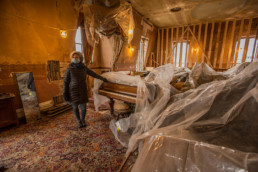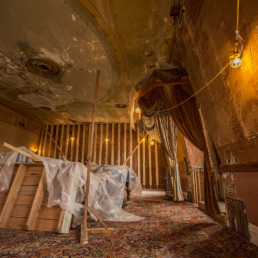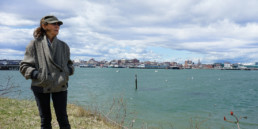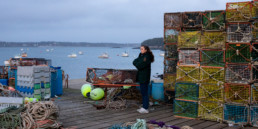The Island’s Star
Vinalhaven carries Robert Indiana’s artistic legacy forward
STORY BY PHIL CROSSMAN PHOTOS BY SHERI ROMER
In 1933 while he was in the first grade, Robert Clark created a painting for a beloved teacher. Forty years later, after his iconic LOVE image swept, un-copyrighted and thus less fulfillingly than might have otherwise been the case, through the graphic world of publishing, television, movies, postage stamps, sculpture, record jackets, and greeting cards, he, now Robert Indiana, invited her to visit him in his New York City studio. She’d been wise to have kept the painting.
For a while, particularly after visiting the palatial state house in Indianapolis as a youngster, Bob had wanted to be an architect, and while the required math obstructed his interest, admiration of structure and design was never far from his heart.

Years later, when the ferry carrying him and his host, famed Life magazine photographer Eliot Elisofon, swung into Carver’s Harbor on Vinalhaven Island, it was the sight of a magnificent three-story building in the center of the village that captured his attention.
Known today as the Star of Hope—Bob’s designation—it was a majestic structure, a testament to the opulence of Second Empire Victorian design and was then the home lodge of the Independent Order of Oddfellows. It, and another nearly identical building, the Masonic Hall, stood like devoted sentinels on both sides of the Memorial Hall, a building just as imposing but lacking the distinctive mansard. The three lorded regally over the island’s Main Street.
The Memorial Hall, home to all that was communal on Vinalhaven, was torn down in 1973, having fallen victim to some heart-wrenching shortsightedness but, it must be acknowledged, also to the enormous cost of upkeep. The Masonic Hall had burned six years earlier.
A number of subtleties distinguish a Second Empire from a conventional mansard roof. Those that distinguished Bob Indiana from most other islanders were less subtle. He was gay, not very quiet about it, yet reclusive. And melodramatic, if often simply in the service of drama.
Elisofon ultimately purchased the Star of Hope from the lodge, which had been inactive for several decades, rented it to Bob, and later he was invited to buy it. He was by then a renowned pop artist on a par with and an acquaintance of such stars of the genre and time as Andy Warhol, Roy Lichtenstein, and Jasper Johns.
Bob occupied the second and third floors just as the old order had and used the two big first floor former storefronts as workspace and storage for his rapidly accumulating trove of creation and similarly amassing accolades.
By the early 2000s the Star of Hope Lodge was consumed by Bob’s presence and creativity. He was honored by the Whitney Museum in New York City with a retrospective of his work, an event, given the long-ago misappropriation of LOVE, he characterized ironically as “Forty Years Too Late.”
Still, Robert Indiana described himself “at ease” with his place in art history and with his place here in this community, and his own peculiar occupancy of a place called the Odd Fellows Hall was never lost on him.

As Bob and his residency wore on, so did the building he loved. During his last exceedingly cloistered decade, it deteriorated very badly, to such an extent that pigeons, four-legged critters, and, most damaging, rainwater, each finding increasingly easy access, were accelerating rot and deterioration.
Bob died in 2018, but two years earlier had left a will creating the Star of Hope Foundation, leaving his considerable estate to it and prescribing that the building become “an art environment, open to the public…” The foundation had three directors.
When he died, the board found itself one shy of that requisite minimum and Maine’s attorney general, concerned about the irresponsible disposition of assets and that Bob’s wishes be adhered to, asked Larry Sterrs, a man with a long and successful record of non-profit management here in Maine, to help out.
Bob’s death quickly and unfortunately precipitated the initiation of much—some clearly covetous—litigation, a growing accumulation of obstruction that stood in the way of implementing Bob’s wishes and of the critically urgent need for beginning work on the building while there was still time to save it.
The board, now comprising Sterrs and two new members, Vinalhaven real estate agent and native Kris Davidson, and Patricia King, vice president of Waterville Creates and former associate director of the Colby College Museum of Art, focused first on the need to stabilize the deteriorating building so serious restoration could begin.
Plan A, then, was to get the foundation, sole beneficiary, up and running and immersed in the varied litigation in an effort to promote enough accommodation among litigants that stabilization could begin.
Although there’d been an initial examination, the foundation soon discovered that water damage and resultant loss of structural integrity was much worse than first understood, such that the building was in danger of bursting from its skeletal remains.
On a memorable and discouraging day in December of 2019, workers exposed an interior wall and discovered a corner post, one of several responsible for holding aloft the massive three stories above, was, as were the others, completely rotted. A much more demanding effort was required to achieve the desired stabilization and it was not until March of 2020 that the foundation could declare it was making progress instead of simply stemming deterioration.
Another discovery, not troubling but certainly surprising, revealed itself when the two ground floor levels, east and west, were found to be at significantly different elevations. Apparently, the Oddfellows, having perhaps occupied only the modest second floor of a simple gabled building on the same spot since 1885, had, in 1896, acquired a similar building next door, then joined the two by topping them with the third story mansard and a grand entrance and stairway between—quite a feat. The order’s home suddenly assumed truly majestic proportions, entirely appropriate and in keeping with the group’s royal proceedings and serving them well until the 1930s when membership began to dwindle.
Eventually, after a year or so of work involving vastly more structure-saving stabilization than had been anticipated, the Star of Hope is today nearly ready for stage II. This will continue to be a labor of love, one that is clearly regarded as such by Rockport Builders, the workers who have accomplished this special work, and by a deeply appreciative and grateful community.
Phil Crossman is one of Vinalhaven’s oldest citizens, which is really not saying much given the number of elderly in residence. Other than that, he serves on the town select board; has authored four books, including his last which recalls his first time (kiss, that is); writes a regular column for The Working Waterfront and The Wind; and owns the Tidewater Motel.
Phil Crossman is one of Vinalhaven’s oldest citizens, which is really not saying much given the number of elderly in residence. Other than that, he serves on the town select board; has authored four books, including his last which recalls his first time (kiss, that is); writes a regular column for The Working Waterfront and The Wind; and owns the Tidewater Motel.






